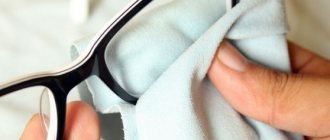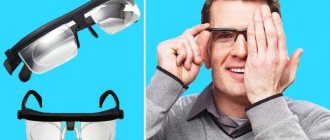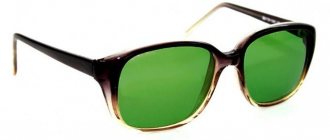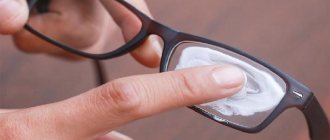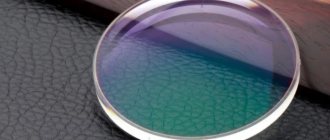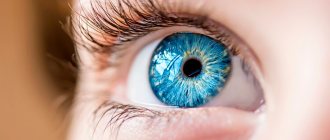Vision problems, which are collectively known as “computer vision syndrome” (hereinafter referred to as “computer vision syndrome”), unfortunately, are one of the dangerous consequences of prolonged communication with a computer. Not long ago, the American association of manufacturers and suppliers of the optical industry, Vision Council of America (VCA), conducted a study, finding that about 70% of adults regularly experience some kind of discomfort as a result of working for long hours at the computer (eye strain, dryness, redness, blurred eyes). vision, headaches, lower back pain, neck pain or general fatigue).
Causes of computer vision syndrome
Of course, there is an immediate impulse to blame everything on the mysterious invisible radiation emanating from the screens. The myth of their existence is firmly entrenched in the minds of ordinary people, along with the desire to protect themselves from them by all available means. In fact, it’s high time for us to say goodbye to this fear. Indeed, early models of monitors (huge CRT monitors, if you remember), which were widespread 10-15 years ago, emitted a fairly strong electromagnetic field. True, it turned out to be not so harmful.
In the textbook “Eye diseases. Fundamentals of Ophthalmology: Textbook / Ed. V. G. Kopaeva." it says: “... already in 1998 at the International Congress “Man in the Megalopolis of the 21st Century” it was reported that the indicators of the fields mentioned above are below acceptable hygienic standards and do not have a harmful effect on the user’s body...” (Chapter 24. Computer vision syndrome).
One way or another, outdated technology has long been replaced by liquid crystal displays, the radiation from which is much lower than the minimum permissible limit. As experts say, the power cable from your laptop today produces more radiation than its monitor. But the problem of GLC has not gone away and has even gotten worse as we spend more and more time looking at glowing screens.
In fact, three factors are responsible for the occurrence of CLC:
- The picture on the monitor is unnatural and difficult for the human eye to perceive.
- As a rule, we don’t think about the proper organization of our workspace - we use uncomfortable furniture, sit in an awkward position at an awkward distance from the monitor and look at it from an awkward angle.
- We forget to pause while we work just to relax our eyes. But rest and simple eye exercises are the main means to keep them healthy.
The last two points are the most important. It is enough for us to adjust our habits so as not to worry about the problem of GLC. Glasses for working on a computer can only serve as an additional auxiliary accessory, but will not solve the problem if we continue to sit in one position for hours, intensely focusing on the screen. But, alas, fighting your habits is always the most difficult.
What interesting things can you say about glasses?
This seemingly simple accessory has a fairly rich history, which is associated with many historical figures.
When were glasses invented?
The Arabs are considered the first inventors. The remedy was elementary and completely different from what we are used to seeing. The Arab scientist Ibn al-Haytham described the structure of the eye and its ability to see better using a spherical piece of glass or translucent stone.
But in the version in which we are accustomed to seeing them, the first, according to the Pisans, was invented by the monk Alessandro della Spina in the 13th–14th centuries . The Florentines, in turn, claim that the first was the monk Salvino d'Armato during the same time period. They were originally intended for people with farsightedness.
Glasses for myopia were invented already in the 16th century. Historians compare this event with the invention of printing and the spread of literacy. The expensive accessory was first worn by the ruling circles: kings, electors, popes. In the seventeenth century they were brought to Russia: they were used by Patriarch Nikon and Tsars Mikhail Fedorovich and Alexei Mikhailovich.
It is noteworthy that at first they were fastened with an elastic band , and in the 18th century Edward Scarlett invented the bows that we use to this day.
Is there any harm from a computer?
No matter how hard the developers try, computer monitors are still far from perfect, and the image they transmit is not adapted for comfortable perception by the human eye. Here are the main problems that make displaying on screens difficult for us:
- constant bright glow;
- flicker
- low contrast;
- not comfortable radiation spectrum (blue).
Let us remind you once again that there is no electromagnetic radiation, and you should not be afraid of it. This is a proven fact.
How do computer glasses work?
Computer glasses use lenses with special properties designed to optimize your vision when interacting with digital screens. They are designed to: reduce glare, increase contrast and soften the visible light spectrum.
The main types of coatings for computer lenses:
Metallized coating ( EMI): This coating can already be called obsolete, since it was developed to protect against electromagnetic radiation from CRT monitors. As we said above, now the problem of electromagnetic radiation is not so serious, so EMI coverage becomes useless. Although, if you are a lover of rarities and still use an old monitor, then perhaps a pair of such lenses will be useful to you.
Anti-Reflective Coating (AR) : Anti-reflective coatings reduce glare from screens and light sources around us, thereby reducing eye strain. Specially designed computer and gaming glasses from Gunnar and VC Eyewear are most often produced using just such coatings. If you have ever made custom glasses or are planning to do so, then you may have come across lenses with HMC multi-coating in optical catalogs - it also includes an anti-reflective coating that performs these functions. Please note that this coating should not be confused with polarizing, since polarized lenses, on the contrary, can make it difficult to interact with computer and smartphone screens - read more about polarized lenses here.
Colored lenses : Many computer glasses rely on certain lens colors to increase the contrast of the visible image. Usually it is a yellow tint, less often – brown or orange. The disadvantage of this method is that glasses noticeably distort color reproduction, which is unacceptable if you are involved in photography, design, video editing, etc. In all other cases, colored computer lenses will be quite comfortable, although it will take some time to get used to their color.
In our optics you can order the production of computer glasses with Cryol 1.56 HMC (Chemi-Computron blue blocker) Brown 80% lenses, which have a metallized and anti-reflective coating, a brown tint and a blue filter.
Blue Filter : These are state-of-the-art computer lenses that aim to reduce visible blue light. Recent studies have proven that the blue spectrum is a strong irritant for the retina. At the same time, digital screens emit a lot of blue. The name of such lenses usually contains the word “blue”: “Blue coating”, “Blue blocker”, etc. The big advantage of blue filter lenses is that they can be completely transparent and do not distort color reproduction. Therefore, glasses with such lenses can be used even in the office without attracting the attention of others. They will not be a hindrance for professionals working with graphics either.
We can recommend the manufacture of computer glasses with lenses
Cryol 1.56 Blue Coating is a simple and inexpensive blue filter option. You can order glasses with or without diopters.
Cryol Blue Max 1.61 HMC is a more expensive option, but more functional. In addition to the blue filter, these lenses contain anti-reflective coating, protection against scratches and dirt. They can also be with or without diopters.
Meaning of the word glasses
glasses
are the most common of optical devices, designed to improve human vision and help it with optical imperfections of the eye (corrective glasses) or to protect the eyes from various harmful influences (protective glasses). The first reliable information about the use of O. dates back to the 13th century. (Italy; in the same period, the action of O. was described by the English scientist R. Bacon), although references to the use of polished natural crystals to improve vision are found in ancient authors. The empirically developed technology for producing lenses for optical purposes was the basis for rapid progress in the design and manufacture of optical systems from the beginning of the 17th century, during the era of scientific discoveries in optics associated with the names of G. Galileo, I. Kepler, R. Descartes, I. Newton and etc. The human eye is a naturally complex and perfect optical system. Its ability to focus images of objects on the retina at varying distances to them is called accommodation of the eye. If, when viewing a distant object (from each point of it, an almost parallel beam of rays enters the eye), the accommodation mechanism is not activated and the image of such an object is formed on the retina, the eye is called emmetropic (normal in the ordinary sense of the word); its main focus is on the retina. Normal refraction is impaired in the ametropic eye; the main focus (and, accordingly, the plane of images of distant objects) is shifted relative to the retina and is located either in front of it (myopic, or myopic, eye) or behind it (hyperopic, or farsighted, eye). In ophthalmology, myopia and mild hypermetropia are also considered normal. In addition, astigmatism of the eye is common; The refractive power of an astigmatic eye is different in different planes passing through the optical axis of the eye (different meridians). An astigmatic eye does not produce point images of point light sources. Corrective glasses correct errors of refraction and accommodation of the eye. For disorders of refraction only and in the absence of astigmatism, spherical lenses are used in O., the refractive power of which is the same along all meridians. They are divided into collective (positive), prescribed for farsightedness, and scattering (negative) - for myopia. For the former, the main focus is behind the glass, for the latter - in front of it (see Lens). With their help, images of distant objects are combined with the retina of the eye. O. that correct ametropia are called O. for distance. The optical power of such lenses depends on the degree of ametropia and is expressed in diopters (m-1). To correct ametropia complicated by astigmatism, astigmatic (toric) lenses with a refractive power that varies in different meridians are used in O. With simple astigmatism, the eye is emmetropic in one of the mutually perpendicular main meridians (their inclination to the vertical may be different) and ametropic in the other. However, often astigmatism is a combination of myopia (or farsightedness) of varying degrees in the main meridians (compound astigmatism) or myopia in one main meridian and farsightedness in another (mixed astigmatism). To correct all types of astigmatism, spherotoric lenses are used (one of their surfaces is spherical, the other is toric) or more complex lenses with surfaces of double curvature (i.e., with different radii of curvature in the main meridians). With age, the ability of accommodation decreases - presbyopia develops. There is a need for vision for clearly distinguishing close objects, reading, and other things (often while maintaining the usual visual perception of distant objects). Such lenses with positive lenses are called near lenses. For presbyopia and some other visual impairments, lenses with glasses are prescribed, the upper part of which has one optical power (sometimes equal to 0) and is used to look into the distance, and the lower part has a different optical power, for working at close range. Such lenses, which combine close-up and distance lenses in one frame, are called bifocal. In their absence, you have to use 2 pairs of lenses - for near and for distance. The loss of accommodation is compensated by using O. and with a large number of focuses (multifocal O.). Spectacle glasses of high optical power have undesirable side effects on vision (they do not provide a clear image at the edge of the field of view, distort the shape of objects, affect the size of the image on the retina, and make it difficult to correctly perceive spatial perspective). Biconcave and biconvex lenses have the greatest optical defects, which is why they are no longer used for O. Significantly lower distortions are characteristic of specially designed convex-concave or concave-convex lenses (the so-called meniscal, punctal or anastigmatic lenses). Only such spectacle lenses are produced by industry to date (70s of the 20th century). The small optical deficiencies that still remain in them are usually compensated by the nervous apparatus of visual perception as they get used to it. Glasses of glass must be at a certain distance from the cornea of the eyes, and one from the other - at a distance strictly corresponding to the distance between the pupils. Therefore, O. is a device that requires precise calculation and careful manufacturing. Special requirements are placed on so-called special-purpose O., used for severe combined visual impairments: prismatic O. to correct strabismus, mirror O. to expand the field of view, telescopic O. (designed like a small binocular) for a sharp decrease in visual acuity caused by visual impairment. nerve, retina or choroid, etc. O. are beneficial only if they are prescribed correctly, which requires a thorough examination of the eyes. O.'s appointment, selection and testing of glasses for them are carried out by an ophthalmologist. A type of eye can be considered contact lenses, which are optically superior to ordinary lenses in that they repeat all the movements of the eyeballs on the surface of which they are directly applied. So-called microcorneal contact lenses are made from either glass or (more commonly) a flexible plastic material; in the latter case, they take the shape of the surface of the eyeball with all its changes. Safety glasses protect the eyes from mechanical (dust, metal shavings, etc.) and chemical damage, as well as from the harmful effects of excessively bright or unfavorable spectral composition of light (when welding and smelting metals, working with lasers and other powerful light sources, during prolonged staying in the snow, illuminated by the sun, etc.). In addition to its direct purpose, O. for protection against mechanical and chemical factors must: not reduce visual acuity; provide a sufficiently wide field of view and reliable ventilation of the sub-renal space; fit tightly and evenly to the face without damaging or irritating the skin; do not fog up; have low weight. O. for protection against radiation are made in the form of light filters - neutral or (more often) selective. Selective light filters should, if possible, cut off useless (and often harmful) radiation (ultraviolet and infrared) for vision and retain part of the visible area necessary to solve a specific visual task. A. V. Luizov.Great Soviet Encyclopedia, TSB
Are there any contraindications for computer glasses?
Whether computer glasses will be effective or, on the contrary, will cause you a lot of inconvenience depends both on the correct choice of the glasses themselves and on how your workspace is organized.
When purchasing glasses for your computer, check the quality of their visibility. Computer glasses should not:
- distort the shapes and sizes of objects,
- darken too much
- limit the field of view,
- create interference in front of the eyes (if the lenses get dirty or scratched easily).
The purpose of computer glasses is to relax your eyes, and not create additional problems for them. If you experience any discomfort from glasses, this means that you should not use them.
Ready-made or custom-made glasses?
There is no fundamental difference between ready-made computer glasses and custom-made ones, even in price. In both cases, it is worth clarifying which lenses will be used and whether you are satisfied with their functionality. And, of course, you should pay attention to the quality of components.
By purchasing ready-made glasses for working at a computer, you, of course, quickly and without much hassle solve the problem. Made to order, it will require your time and attention to select the appropriate frames and lenses. The production itself also takes several days. But you decide for yourself what your accessory will look like. And if it turns out that the lenses in your glasses do not suit you, they can be easily and inexpensively replaced.
You can choose computer lenses on our website - following this link. Pay attention to the prices in our catalog - they will pleasantly surprise you. You can also choose frames from us or order the production of glasses.
Preliminary consultation: we will be happy to answer any of your questions by phone +7 or in our optics salon at St. Petersburg, st. Ilyushina 3 (metro station Komendantsky Prospekt) .
glasses I
Morphological and syntactic properties
| case | units h. | pl. h. |
| Them. | — | glasses |
| — | points | |
| — | glasses | |
| — | glasses | |
| TV | — | glasses |
| Etc. | — | glasses |
glasses
Noun, inanimate, masculine, 2nd declension (type of declension plural <м 3*b> according to the classification of A. A. Zaliznyak); unit forms hours are not used.
Root: -points-
;
ending: -i
[Tikhonov, 1996].
Pronunciation
- IPA: [ɐt͡ɕˈkʲi]
(file)
Semantic properties
Glasses
Meaning
- an optical device in the form of two glasses on the arms, used to correct vision in case of myopia or farsightedness, or to protect the eyes from unwanted mechanical or other influences ◆ During a meeting with Leonid Tyagachev, which took place in the middle of this week, the Izvestia correspondent laid in front of him memo from Professor Durmanov: “Are you familiar with this document?” “I’ll put on my glasses now,” answered Leonid Vasilyevich. Andrey Mitkov, “We knew everything without this note.” A year ago, sports officials knew that our athletes would be looked for doping” // Izvestia, 2003 (quote from)
Synonyms
Antonyms
Hypernyms
- device
Hyponyms
- lorgnette, pince-nez, sunglasses
Related words
| Closest relationship | |
| |
| List of all words with the root “ok-/och-/ochk-” | ||
| ||
Etymology
Comes from “oko” - eye.
Phraseologisms and stable combinations
Translation
| List of translations | |
| |
Anagrams
- Chico
Bibliography
- Melchuk I.A., Zholkovsky A.K.
“Glasses” // Melchuk I.A., Zholkovsky A.K. Explanatory and combinatorial dictionary of the Russian language. Experiments in semantic-syntactic description of Russian vocabulary. Wiener Slawistischer Almanach. Sonderband 14. Wien, 1984, p. 554-558.
